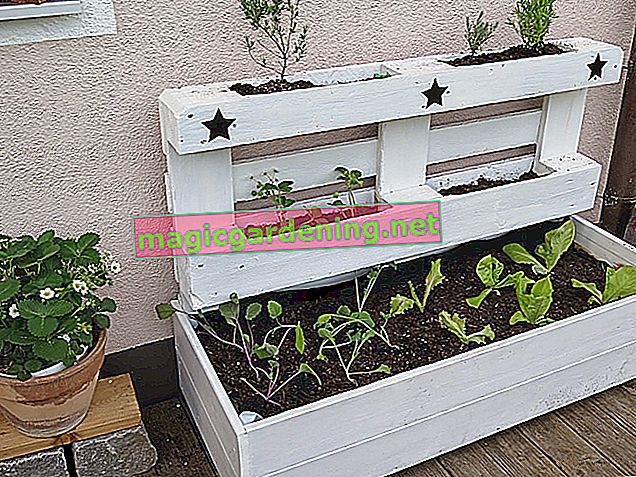
Planting chrysanthemums properly
In order to properly plant a chrysanthemum, only a few aspects are relevant. Follow these steps:
- Put the potted young plant in water for 10-20 minutes
- In the loosened, weeded soil, create a pit with twice the volume of the root ball
- Optimize the excavated earth with compost and horn shavings
- Pot the flower and plant it up to the root neck
- Tie tall growing varieties to a support rod
also read
- Blooming autumn ornament - planting chrysanthemums
- Chrysanthemums - properly caring for young plants
- Properly care for balcony chrysanthemums
Press the soil firmly with your hands and pour on with a good sip of water. Finally, spread a layer of mulch, with fern leaves, leaves, clippings, bark mulch or nettles. In the pot you use compost-based potted plant soil as a substrate and use potsherds to spread a drainage over the water drain.
Continue reading
Care tips
The cornerstones of professional care include a balanced water and nutrient balance, the right cut and careful wintering. All important details at a glance:
- Water the flower as soon as the substrate has dried
- From May to September, fertilize organically every 14 days or apply a slow-release fertilizer in May and July
- From a height of 50 cm, shorten it once by half to optimize stability
- Regularly clean withered flowers
- Do not cut back the retracted leaves near the ground until late winter
Pile hardy chrysanthemum species and varieties after the autumn flowering with leaves, straw or coniferous twigs. Spread jute towels or a felt hood over the bushes. Put potted plants in the frost-free winter quarters. Do not allow the plants to dry out or fertilize them during winter.
Which location is suitable?
The species-rich flower favors a sunny to partially shaded location, without summer accumulation heat. The higher the chrysanthemum grows, the more sheltered the location should be. Cultivated as a houseplant, the flower adorns a wintry window sill in a sunny spot at temperatures of 15-18 degrees Celsius.
Continue reading
The correct planting distance
A general measurement of the perfect plant spacing is not possible in view of the wide variety of species and varieties. To determine the appropriate distance to the neighboring plant, take a look at the expected height and divide this value by 2.
What soil does the plant need?
In order for chrysanthemums to stage their blooming spectacle, they should have the following soil properties:
- Nutrient-rich and humic
- Fresh and moist and without the risk of waterlogging
- Sandy-loamy, permeable
If in doubt, prepare the soil with simple soil additives so that the flower feels comfortable. You optimize sandy soil with mature compost, while heavy soil is improved with sand.
What is the best time to plant?
The best time to plant chrysanthemums is spring and early summer through mid / late June. At this time you give the flower enough time to establish itself in the substrate and to survive the winter in good health. Specimens pulled in containers can still be planted in the ground in autumn, provided the variety is hardy.
When is the flowering time?
The flowering period starts in August / September when the days get shorter. Depending on the type and variety selected, the flowering extends over the months of September and October until November. Half-height chrysanthemums bloom in the bright window seat at 15-16 degrees Celsius throughout the winter as indoor plants.
Properly cut chrysanthemums
If you cut out dead flowers regularly, this measure will help to extend the flowering time. Once a chrysanthemum bush has reached a height of 50 centimeters for the first time, cut back all shoots by half. This trick improves stability without affecting the flower. However, do not prune close to the ground until late winter so that the foliage can protect the plant from frost and cold moisture.
Continue reading
Watering chrysanthemums
Water the flower regularly and thoroughly, without causing waterlogging. You water a dense chrysanthemum bush even after a rain shower, as raindrops do not get to the ground. If the flower lets its leaves droop, it should be watered immediately.
Continue reading
Fertilize chrysanthemums properly
The nutritional requirements of chrysanthemums are medium to high. Fertilize the flower every 14 days from May to September with an organic or mineral-organic preparation. Repeated mulching with compost is recommended. Fertilize winter-flowering house plants until the end of the flowering period with a liquid fertilizer, which you add to the irrigation water every second watering.
Diseases
The chrysanthemum is primarily prone to fungal infections. The two most important diseases at a glance:
- Powdery mildew: fight the floury-white fungal lawn with milk-water in a ratio of 1: 9
- Chrysanthemum rust: remove diseased leaves from yellowish-green spots and fight pathogens with a canola oil preparation
It is essential to avoid watering the leaves and flowers when watering. This prudence serves as an effective prevention against diseases.
Pests
Arm the chrysanthemum against the following pests:
- Leaf miner fly: collect the 3 mm insects, cut off the infected leaves, fight with neem preparations
- Leaf bugs: shake off the winged pests, 5-10 mm in size, in the early morning on a mat and fight with nem seeds
- Black weevil: take action against adult black beetles and larvae with bait traps and nematodes
If the ubiquitous aphids attack the flower, you can get rid of the plague with a soap solution of 15 ml soft soap, (€ 17.27 at Amazon *) 1 splash of alcohol and 1 liter of water.
Overwinter
Some chrysanthemum species and varieties have the potential to survive winter in the bed. The pink blooming winter aster 'Julchen' is one of them, as are the white blooming varieties 'White Bouquet' and 'Poesie'. However, the plants cannot survive the cold season without taking any protective measures. How to do it right:
- Before the first frost, pile the flower thick with leaves, straw, compost or pine needles
- Additionally protect bushes with newspaper, jute tape or garden fleece
- Leave the withered leaves on the plant until early spring and then cut them off
In the bucket or balcony box, chrysanthemums ideally move to bright winter quarters where temperatures are between 5 and 10 degrees Celsius. Only water the flower enough so that the root ball does not dry out and stop applying fertilizer.
Continue reading
Propagate chrysanthemums
Use the uncomplicated cutting method to propagate your most beautiful flower by variety. In the period from May to June, cut 10-15 cm long, non-flowering head cuttings. This is how the offspring is successful:
- Make the cut just below one eye
- Defoliate the offshoot except for the upper pair of leaves
- Plant in small pots filled with pricking soil
In the partially shaded, protected location, keep the substrate constantly moist. If the first shoot appears, the underground roots run as desired. To force the process, put a transparent hood over the cutting, which is aired daily.
Continue reading
How do I transplant properly?
Replanting the perennial every 3-5 years helps maintain vitality and willingness to flower. At the same time, this measure serves for an uncomplicated increase. In early spring, dig up the root ball and cut it up with the spade. The less the roots are damaged, the better for the flower. Plant the segments at the new or previous location without any further delay.
Chrysanthemums in the pot
Chrysanthemums in the pot adorn the balcony, terrace and house entrance. They also set eye-catching accents on the partially shaded windowsill. In order for the blooming splendor to expand unrestrictedly for 20 to 40 days, this care is essential:
- Keep the substrate constantly slightly moist
- Apply liquid fertilizer every 14 days during the growth and flowering period
- Clean up dead flowers
- Only cut the foliage close to the ground when it has completely withered
When winter knocks on the garden door, chrysanthemums in pots move to the bright, frost-free winter quarters. The danger that the root ball will freeze through is too great due to its exposed location. Winter-flowering varieties should be watered and fertilized in a sunny location at temperatures not exceeding 20 degrees Celsius.
Continue reading
Are Chrysanthemums Poisonous?
With regard to the toxicity of a chrysanthemum, the all-clear can be given for humans. For pets, especially dogs and cats, however, the flower is life-threatening. Even small amounts of the flowers and leaves cause the worst symptoms of poisoning. Therefore, do not include the ornamental plant in the planting plan if you want to protect your four-legged friends.
Continue reading
Chrysanthemums do not bloom
If the hand-grown chrysanthemum simply does not want to bloom, it receives too much daylight. As a typical short-day plant, the flower induction is closely related to the duration of day and night. You can simulate the natural process to animate the flower to bloom. To do this, carry the plant into a dark room in the early evening or put an opaque cover over it. If the flower receives less than 10 hours of light per day for a period of 6 weeks, the longed-for floral florets unfold.
Brown leaves
Brown leaves indicate that the flower is not feeling well. If it is mainly older leaves, there is a lack of nutrients. Fertilize with a liquid fertilizer for flowering plants, as this is absorbed more quickly. If all the leaves turn brown, the flower suffers from drought stress. Water chrysanthemums regularly and abundantly, even after a rain shower.
How do I make chrysanthemums bloom?
In professional nurseries, it is common practice to control the flowering of chrysanthemums with a simple blackout trick. Since the flower is a short-day plant, it waits to bloom until the days get shorter. If you simulate this process, you will attract the flower accordingly early. This is how the horticultural trick works:
- Put a black bucket over the flower in the early evening
- Leave the cover in place until the chrysanthemum is in the light for less than 10 hours
If you do this for 6 weeks, the buds will open regardless of the calendar date. The short day simulation only works to your full satisfaction if the flower is not covered by a single light beam while it is darkened.
Nice varieties
- Fire magic: magnificent garden chrysanthemum with purple, double flowers from August to October
- Havel swan: white blooming and bulging, the flower enchants from October to November; Growth height 80 cm
- Bees: captivates with deep yellow pompom flowers in late autumn; Growth height up to 90 cm
- Autumn ruby: majestic chrysanthemum with ruby red, double flowers; Growth height 100-110 cm
- Mary Stoker: historical variety with simple bronze-yellow flowers and a yellow heart; Height 60 cm








